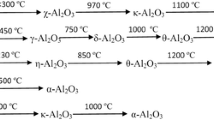Abstract
In the present work, nanoporous alumina microspheres have been synthesized by sol–gel technique. Acid deficient aluminum nitrate and a mixture of equimolar HMTA-Urea were used as starting materials. The prepared sol then injected as droplets into hot oil column to give spherical shape. After calcinations the samples were characterized by scanning electron microscope, fourier transform infra-red spectroscopy, thermogravimetry–differential thermal analysis, X-ray diffraction and N2 adsorption–desorption isotherms. With respect to the results achieved from the above analyses, it was found that nanoporous alumina microspheres with controllable size and morphology can successfully be produced through sol–gel method.









Similar content being viewed by others
References
N.Z. Logar, V. Kaučič, Acta Chim. Slov. 53, 117 (2006)
J.S. Beck, C. Vartuli, W.J. Roth, M.E. Leonowicz, C.T. Kresge, K.D. Schmitt, J. Am. Chem. Soc. 114, 10834 (1992)
K. Na, M. Choi, R. Ryoo, Micropor. Mesopor. Mat. (2012). doi:10.1016/j.micromeso.2012.03.054
H.Y. Zho, G.G. Lu, Langmuir 17, 588 (2001)
S. Pavasupree, Y. Suzuki, S. Pivsa-Art, S. Yoshikawa, Sci. Technol. Adv. Mater. 6, 224 (2005)
E.S. Kikkinides, K.A. Stoitsas, V.T. Zaspalis, J. Colloid Interf, Sci. 259, 322 (2003)
R. Dawson, A.I. Cooper, D.J. Adams, Prog. Polym. Sci. 37, 530 (2012)
S. Blankenburg, M. Bieri, R. Fasel, K. Müllen, C.A. Pignedoli, D. Passerone, Small 6, 2266 (2010)
C.W. Huang, H.C. Wu, Y.Y. Li, Sep. Purif. Technol. 58, 219 (2007)
P. Jevnikar, K. Krnel, A. Kocjan, N. Funduk, T. Kosmač, Dent. Mater. 26, 688 (2010)
A.F.M. Leenaars, A.J. Burggraaf, J. Membrane Sci. 24, 245 (1985)
C. Boss, E. Meurville, J.M. Sallese, P. Ryser, J. Membrane Sci. 401, 217 (2012)
M. Haji-Sheikh, A. Bose, L. Wardzala, US Patent 8132,457, March 13, 2012
M. Trueba, S.P. Trasatti, Eur. J. Inorg. Chem. 2005, 3393 (2005)
S. Moriguchi, K. Naito, S. Takei, J. Chromatogr. A 131, 19 (1977)
D.J. Burgess, A.J. Hickey, Microsphere Technology and applications, in Encyclopedia of pharmaceutical technology, vol. 10, ed. by J. Swarbrick, J. Boylan (Marcel Dekker, New York, 1994), pp. 1–29
P. Luo, T.G. Nieh, Biomaterials 17, 1959 (1996)
Y. Li, K.A. Khor, J. Mater. Process. Technol. 89–90, 532 (1999)
Y.C. Kang, H.S. Roh, S.B. Park, J. Amer. Ceram. Soc. 84, 447 (2001)
S.S. Jada, J. Mater. Sci. 9, 565 (1990)
J.M. Coulson, J.F. Richardson, Chemical Engineering Vol. 2, Fifth ed. (Butterworth-Heinemann, Oxford, 2002)
G. Buelna, Y.S. Lin, Micropor. Mesopor. Mat. 30, 359 (1999)
D. Shi (Ed.), Functional Thin Films and Functional Materials: New Concepts and Technologies, (Tsinghua University Press and Springer-Verlag Berlin Heidelberg, 2003)
P. Innocenzi, Y. L. Zub, V. G. Kessler (Eds), Sol-Gel Methods for Materials Processing: Focusing on Materials for Pollution Control, Water Purification, and Soil Remediation, NATO Science for Peace and Security Series C: Environmental Security, (Springer, 2008)
P. Liu, J. Feng, X. Zhang, Y. Lin, D.G. Evans, D. Li, J. Phys. Chem. Solids 69, 799 (2008)
J. Ray, M. Chaterjee, D. Ganguli, J. Mater. Sci. Lett. 12, 1755 (1993)
N. Dilsiz, G. Akovali, Mater. Sci. Eng., A 332, 91 (2002)
G. Krishna Priya, P. Padmaja, K.G.K. Warrier, A.D. Damodaran, G. Aruldhas, J. Mater. Sci. Lett. 16, 1584 (1997)
S. Kúdela jr, L. Smrčok, Proceedings of Metal 2012: 21st International Conference on Metallurgy and Materials, May 2012, Brno, Czech Republic
D. Santhiya, S. Subramanian, K.A. Natarajan, S.G. Malghan, Colloids Surf. A Physicochem. Eng. Asp. 164, 143 (2000)
M.C. Kung, R.J. Davis, H. Kung, J. Phys. Chem. C 111, 11767 (2007)
H. Abdolmohammad-Zadeh, S. Kohansal, J. Braz. Chem. Soc. 23, 473 (2012)
M. Avram, G.D. Mateescu, Infrared spectroscopy applications in organic chemistry (J. Wiley & Sons, New York, 1972)
H. M. Heise, Infrared and Raman Spectroscopy, ed. by B. Schrader (VCH, Weinheim 1995)
J.L. Collins, M.H. Lloyd, R.L. Fellows, Radiochim. Acta 42, 121 (1987)
C. Karr Jr, P.A. Estep, J.J. Kovach, Amer. Chem. Soc. Div. Fuel Chem. Preprints 12, 1 (1968)
B.C. Lippens, J.J. Steggerda, Physical and chemical aspects of adsorbents and catalysts (Academic Press, London, 1970)
F. Laoutid, L. Bonnaud, M. Alexandre, J.-M. Lopez-Cuesta, Mater. Sci. Eng., R 63, 100 (2009)
R. Kaminskas, I. Barauskas, Ceram-Silikaty 55, 261 (2011)
M. Chatterjee, D. Enkhtuvshin, B. Siladitya, D. Ganguli, J. Mater. Sci. 33, 4937 (1998)
V.R. Palkar, Eur. Phys. J. D 16, 253 (2001)
Y. Li, J.T. Feng, D.Q. Li, Sci. China: Chem. 54, 1032 (2011)
D.E. Newbury, Scanning 31, 1 (2009)
R.T. Yang, Adsorbents: fundamentals and applications (John Wiley & Sons, New Jersey, 2003)
J.B. Condon, Surface area and porosity determinations by physisorption: measurements and theory (Elsevier, Amsterdam, 2006)
Y. Chen, D.D. Dionysiou, Appl. Catal. B 80, 147 (2008)
P. Padmaja, P.K. Pillai, K.G.K. Warrier, M. Padmanabhan, J. Porous Mat. 11, 147 (2004)
V.R. Palkar, Nanostruct. Mater. 11, 369 (1999)
Acknowledgments
Islamic Azad University, Gorgan Branch is acknowledged for financial support. The author would like to thank Mr. Ali Hamrang for XRD measurements.
Author information
Authors and Affiliations
Corresponding author
Electronic supplementary material
Below is the link to the electronic supplementary material.
10934_2013_9689_MOESM2_ESM.pdf
The XRD analysis for ADAN-25 samples with Al/(HMTA-Urea) mole ratios of 1.2 and 1.4 illustrates that the diffraction patterns are essentially identical to each other, indicating that the different Al/(HMTA-Urea) mole ratios employed during the preparation of the precursor do not affect the crystal structure of the final spherical alumina (PDF 178 kb)
10934_2013_9689_MOESM3_ESM.ppt
Energy dispersive spectrum of alumina microspheres (ADAN-25 and Al/(HMTA-Urea) mole ratio of 1.4), calcined at 500 °C, 700 °C, 1100 °C and 1200 °C. EDS analysis indicates that the alumina microspheres are composed of Al and O. The theoretical weight fraction of aluminum in Al2O3 is 52.92 %, which is in good agreement with that obtained from the EDS analysis of the microspheres calcined at 500 °C, 700 °C, 1100 °C and 1200 °C (50.52 %, 52.64 %,49.31 % and 53.07 %, respectively) (PPT 267 kb)
Rights and permissions
About this article
Cite this article
Beiknejad, D. Synthesis optimization, structural evolution and optical properties of hierarchical nanoporous alumina microspheres prepared by continuous soft chemistry method. J Porous Mater 20, 1075–1086 (2013). https://doi.org/10.1007/s10934-013-9689-z
Published:
Issue Date:
DOI: https://doi.org/10.1007/s10934-013-9689-z




